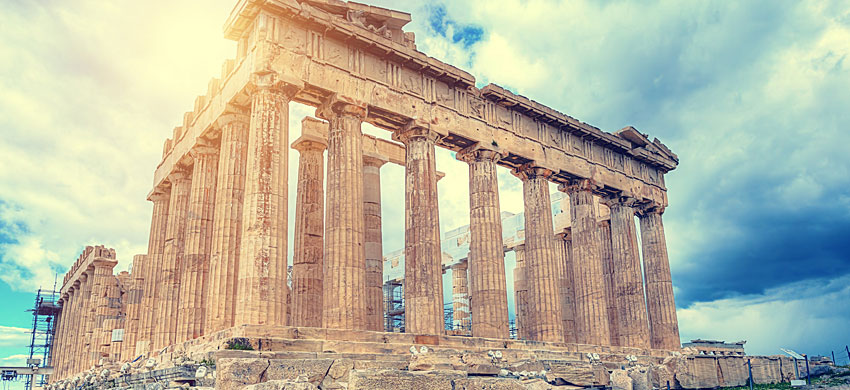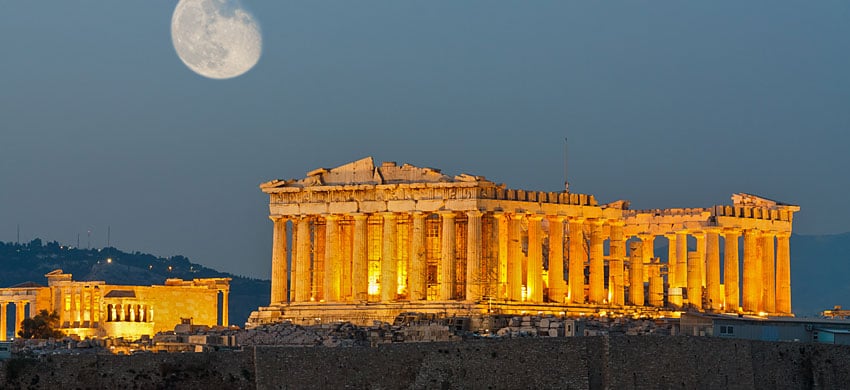
For over two thousand years the Parthenon has been the symbolic building of Athens: the most famous Greek temple in the world was in fact a star even in antiquity, extolled by its contemporaries as an absolute architectural masterpiece. Perched atop the Acropolis, the hill that overlooks the center of the Greek capital and which in antiquity was its beating heart, is a monument in which the classical ideal of beauty and harmony becomes concrete.
Its colossal dimensions and the height at which it is located mean that it can be seen from several kilometers away, so that it is guaranteed that during your walks in the center of Athens you will see it continually popping up within your visual horizon.
The eye will immediately fall there, first because it is impossible to look away from such a wonder, then because the Parthenon changes its appearance depending on the light conditions. During the day it is an impressive white giant, at sunset the pink reflections soften its profile and make it romantic, at night, all lit up, it is simply magical.
Needless to say, a visit to the Parthenon is a must, after all, isn’t that the main reason for coming to Athens? But you can enjoy the most famous artifact of ancient Greece even more by taking part in a guided tour that will give you an in-depth look at the history of this extraordinary building.
If you want to add something special to your Athens vacation, treat yourself to a hotel with an Acropolis view: you will invariably find yourself with your nose in the air trying to imagine the Parthenon in its ancient splendor, a riot of marble, gold and bright colors.

Of the original Parthenon unfortunately much has been destroyed or stolen. So what can you still see?
The mighty Doric columns placed on the outer sides of the temple are the best preserved element: even today we can admire the enormous size and convex shape that together with the curvature of the base creates the optical illusion of absolute perfection. There were 50 in total: some are in good condition, others are almost completely destroyed.
Very little remains of the pediments, the triangular-shaped elements placed at the top of the columns on the shorter sides. Once they were decorated with elaborate sculptural motifs: one depicted the birth of the goddess Athena from the head of Zeus, the other the famous race between Poseidon and Athena, won by the latter, to grab the honor of seeing dedicated the city.
The term metopes is used in architecture to refer to the stone panels placed on the cornice of the temple, between the pediment and the columns; generally, they are interspersed with triglyphs, stone panels with three vertical grooves.
The metopes of the Parthenon are famous for the wonderful sculptural decorations designed by Frida, depicting well-known scenes from Greek mythology and history: the taking of Troy, the quarrel between the Centaurs and the Lapiths during a wedding banquet, Theseus and the young Athenians fighting against the Amazons, the gods of Olympus fighting with the Giants. Also in this case it can be seen more in the museums than in the Acropolis.
It has not instead arrived to our days the statue of Athena Parthenos, from which the name of the temple derives.
It is not possible to enter inside the Parthenon: the famous monument can be visited by walking around it. In order to see the Parthenon up close, it is necessary to purchase a ticket for the Acropolis of Athens: there are no tickets for the Parthenon alone.
There are standard tickets for the Acropolis alone, or combination tickets or tourist passes with access to multiple attractions, and the Acropolis is included in all guided tours of Athens.
Choose what to buy based on your interests and the amount of time you’ll be in the city, but whatever you choose, make your purchase online, ideally before you leave. The Acropolis is one of those attractions for which it is strategic to arrive with the ticket in your pocket (or smartphone): being a monument visited by thousands of people every day, the queues at the ticket offices are always very long.
For more information on the Acropolis (opening hours, available tickets, tours and other useful info) visit the page that we have dedicated to it.
If you are short on time and would like to take part in a complete tour of the Acropolis, we recommend that you choose a guided tour among those that we propose below.
There are no buses or shuttles that take you directly to the Parthenon: you can only get there on foot by climbing the paths that start from the ticket offices of the Acropolis (there is more than one, located in different points) and a steep staircase. Access to the archaeological site is through the Propylaea the ancient monumental entrance.
To reach the ticket offices of the Acropolis we recommend that you take the subway, which is easier and faster than buses. The nearest stops are Akropolis and Monastiraki, located about 400 meters from the ticket offices.

The Parthenon is an ancient temple in Doric style with Ionic elements dedicated to the goddess Athena Parthenos. Entirely built in marble from Mount Pentelos, it was built between the mid-fifth century and 432 BC on a project by the architects Callicrate and Ictinus, supervised by Phidias, who was also the author of numerous sculptures that decorated the temple.
The temple has a rectangular plan and rests on a base with three steps. The external colonnades enclosed a sanctuary originally divided into two sectors: in the larger one was kept a huge statue of the goddess, about 12 meters high, made of gold, ivory and precious stones.
Today we see it entirely white, but in ancient times the Parthenon, as well as other ancient buildings, had multicolored and golden elements.
The Parthenon’s uniqueness, such as to make it considered already in ancient times an unparalleled architectural masterpiece, lies in its absolute perfection: it is actually an apparent perfection, the result of barely perceptible optical corrections that harmonize the overall view of the monument.
Two examples of ingenious solutions that have contributed to creating this ingenious optical illusion? The columns at the corners, slightly larger and closer together than the others; the shafts of the columns have a slight bulge about 2/3 of their height that compensates for the slightly concave foundations.
Around the fourth century BC the Parthenon lost its function as a pagan temple: it was used first as a Christian church then as a mosque and finally as a warehouse. The plundering of works of art from the Parthenon began in the seventeenth century by the Venetians but it was the British in the nineteenth century to take away the largest amount.
Still today the remains of the pediments and numerous sculptures of the Parthenon can be admired at the British Museum in London or, to a lesser extent, at the Louvre in Paris and other important European museums.
Fortunately something has remained in Greece as well: what has escaped the spoils of foreigners is on display at the Acropolis Museum, located outside the archaeological site about 1 km away (entrance is not included in the standard Acropolis ticket).
The most serious damage was inflicted on the Parthenon by a blast caused by a mortar shell. The restoration works started in the seventies are still in progress and it is assumed that they will last many more years.
The Parthenon occupies the central part of the Acropolis: you'll find it on your right after crossing the Propylaea. The Acropolis is located in the center of Athens.